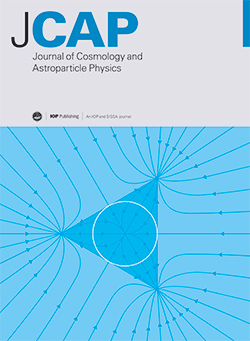Dynamics of the Mixmaster universe in a non-commutative generalized uncertainty principle framework
IF 5.3
2区 物理与天体物理
Q1 ASTRONOMY & ASTROPHYSICS
Journal of Cosmology and Astroparticle Physics
Pub Date : 2025-03-25
DOI:10.1088/1475-7516/2025/03/061
引用次数: 0
Abstract
In this work, we examine the dynamical aspects of the cosmological Mixmaster model within the framework of non-commutative generalized uncertainty principle (GUP) theories. The theory is formulated classically by introducing a well-defined symplectic form that differs from the ordinary one, thereby inducing a general deformation of the Poisson brackets describing a precise class of GUP theories. In this general setting, we first investigate the behavior of the Bianchi I and Bianchi II models using Misner variables. Then, we study the Bianchi IX model in the Mixmaster approximation, which is well-known for accurately reproducing the dynamics of the point-particle Universe approaching the cosmological singularity. We derive the corresponding Belinsky-Khalatnikov-Lifshitz (BKL) map and then, by selecting a specific GUP model associated with string theory, we explicitly investigate its resulting features shaped by the non-commutative GUP scheme. Our findings reveal that the chaotic and ergodic behavior typically observed in the standard BKL map, which characterizes the point-Universe's approach to the singularity, is replaced by quasi-periodic orbits in the parameter space of the theory. This corresponds to an oscillatory behavior of the Universe's scale factors, dependent on the initial conditions.Mixmaster宇宙在非交换广义不确定性原理框架中的动态
在这项工作中,我们在非交换广义不确定性原理(GUP)理论的框架内研究了宇宙学Mixmaster模型的动力学方面。该理论是通过引入与普通形式不同的定义良好的辛形式而经典地表述的,从而引起描述精确一类GUP理论的泊松括号的一般变形。在这种一般情况下,我们首先使用Misner变量研究Bianchi I和Bianchi II模型的行为。然后,我们研究了Mixmaster近似中的Bianchi IX模型,该模型以精确再现接近宇宙奇点的点粒子宇宙动力学而闻名。我们推导了相应的Belinsky-Khalatnikov-Lifshitz (BKL)映射,然后,通过选择一个特定的与弦理论相关的GUP模型,我们明确地研究了由非交换GUP格式形成的结果特征。我们的研究结果表明,在标准BKL映射中通常观察到的混沌和遍历行为(表征点宇宙接近奇点的方法)被理论参数空间中的准周期轨道所取代。这对应于宇宙尺度因子的振荡行为,依赖于初始条件。
本文章由计算机程序翻译,如有差异,请以英文原文为准。
求助全文
约1分钟内获得全文
求助全文
来源期刊

Journal of Cosmology and Astroparticle Physics
地学天文-天文与天体物理
CiteScore
10.20
自引率
23.40%
发文量
632
审稿时长
1 months
期刊介绍:
Journal of Cosmology and Astroparticle Physics (JCAP) encompasses theoretical, observational and experimental areas as well as computation and simulation. The journal covers the latest developments in the theory of all fundamental interactions and their cosmological implications (e.g. M-theory and cosmology, brane cosmology). JCAP''s coverage also includes topics such as formation, dynamics and clustering of galaxies, pre-galactic star formation, x-ray astronomy, radio astronomy, gravitational lensing, active galactic nuclei, intergalactic and interstellar matter.
 求助内容:
求助内容: 应助结果提醒方式:
应助结果提醒方式:


